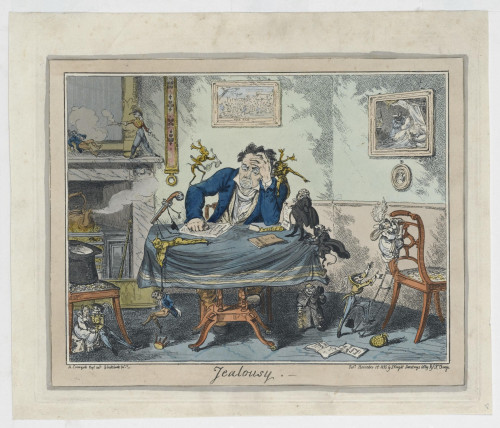95/2009
Collection
Paintings, Prints and Drawings
Brief description
Hand-coloured print on paper, entitled 'Jealousy', by G. Cruikshank and published in London by S. Knight in 1825.
Title
Jealousy
Object name
print
Object number
95/2009
Production person
George Cruikshank (artist)
Alfred Henry Crowquill (artist)
S. Knight (publisher)
Alfred Henry Crowquill (artist)
S. Knight (publisher)
Production date
c.1825 (published)
Production place
City of London (published)
Period
Georgian (1714-1837)
Material
paper
watercolour
watercolour
Technique
etched
painted
printed
painted
printed
Physical description
Hand-coloured etching on paper with the title and publication line printed below the image.
Content description
The scene depicts a man in an interior consumed with jealousy. The room has a dado rail with pale green walls above and beige walls below the rail and a blue fitted carpet. The room is furnished with a table and three chairs with pierced backs and upholstered seats. There is a marble fireplace with a cast iron stove and a brass fender with arched decoration. Above the mantlepiece there is a mirror with a gilt frame. On the walls there are three framed pictures and a floral bell pull with a brass ring at the bottom.
The man is shown sitting with his head resting on his hand and elbow on a book, at a table covered with a rumpled blue cloth and strewn with documents, books and a revolver. The documents include a letter signed “Anonymous” and a copy of a pamphlet entitled “The Revenge”. He is oblivious to the whistling kettle on the stove behind him. There is a framed painting on the wall to his left, hung above an oval portrait of a woman, showing Othello about to smother Desdemona and behind him there is a print with the caption “Horn Fair”, a reference to the horns of a cuckold.
In addition to the everyday objects used as signifiers of jealousy and possible infidelity, the image is full of tiny imaginary figures enacting scenes of provoking behaviour and their possible consequences. There are two horned, imp-like creatures perched on the main protagonists shoulders. One holds out glasses as if to suggest the man cannot see what is before him and the other points to another scene of a woman escaping down a rope ladder to meet her soldier lover; the same characters are subsequently seen embracing under a chair.
Yet more small figures hint at the action the man could take. On one side of the central character, two barristers, present a document with "Damages1000" inscribed on it. On closer inspection one of the lawyers appears to have cloven feet and a tail indicating he is a devil or imp. On the other side a devil holds a rope, as another character (a miniature version of the central protagonist) kicks away a stool and hangs himself. A caricature of an anthropomorphic gun, complete with gloves and a top hat, presents himself to the main character, and on the mantelpiece a scene of dual with pistols, between a soldier and a man in a frock coat is shown, with the soldier shooting the man. In this version of the print the soldier has not been coloured consistently in the same uniform, but the style of uniform, moustache and hat, as well as the brown trousers and blue frock coat of the other male figure are consistent, suggesting that the human figures are all meant to represent the same characters in the narrative.
The man is shown sitting with his head resting on his hand and elbow on a book, at a table covered with a rumpled blue cloth and strewn with documents, books and a revolver. The documents include a letter signed “Anonymous” and a copy of a pamphlet entitled “The Revenge”. He is oblivious to the whistling kettle on the stove behind him. There is a framed painting on the wall to his left, hung above an oval portrait of a woman, showing Othello about to smother Desdemona and behind him there is a print with the caption “Horn Fair”, a reference to the horns of a cuckold.
In addition to the everyday objects used as signifiers of jealousy and possible infidelity, the image is full of tiny imaginary figures enacting scenes of provoking behaviour and their possible consequences. There are two horned, imp-like creatures perched on the main protagonists shoulders. One holds out glasses as if to suggest the man cannot see what is before him and the other points to another scene of a woman escaping down a rope ladder to meet her soldier lover; the same characters are subsequently seen embracing under a chair.
Yet more small figures hint at the action the man could take. On one side of the central character, two barristers, present a document with "Damages1000" inscribed on it. On closer inspection one of the lawyers appears to have cloven feet and a tail indicating he is a devil or imp. On the other side a devil holds a rope, as another character (a miniature version of the central protagonist) kicks away a stool and hangs himself. A caricature of an anthropomorphic gun, complete with gloves and a top hat, presents himself to the main character, and on the mantelpiece a scene of dual with pistols, between a soldier and a man in a frock coat is shown, with the soldier shooting the man. In this version of the print the soldier has not been coloured consistently in the same uniform, but the style of uniform, moustache and hat, as well as the brown trousers and blue frock coat of the other male figure are consistent, suggesting that the human figures are all meant to represent the same characters in the narrative.
Content object
chair
table
bell pull
kettle
fireplace
poker
mirror
mantelpiece
fender
table
bell pull
kettle
fireplace
poker
mirror
mantelpiece
fender
Dimensions
Height: 24.7cm
Width: 29.5cm
Width: 29.5cm
Website keywords
images of living rooms
living room furniture
seating
tables
fireplaces
ornaments
pictures
living room furniture
seating
tables
fireplaces
ornaments
pictures




